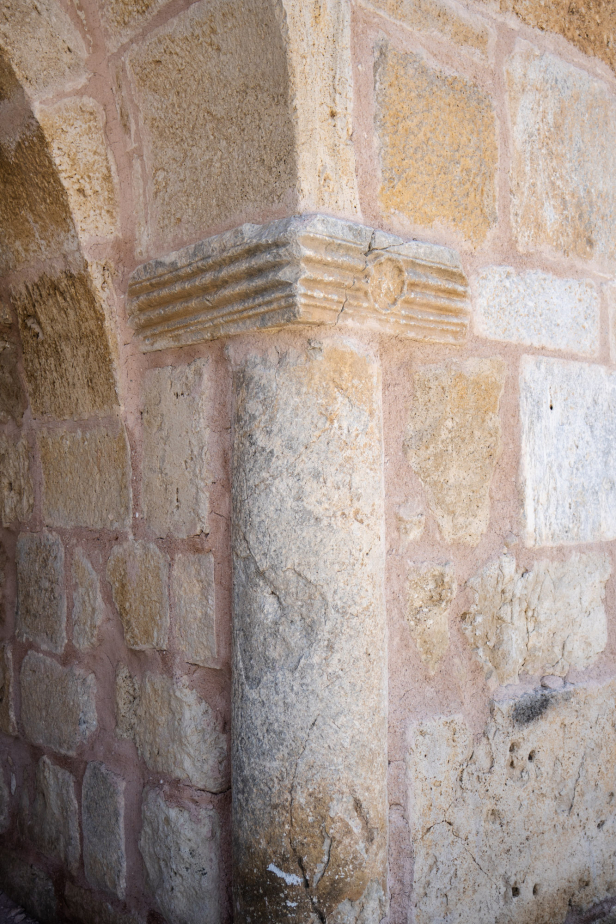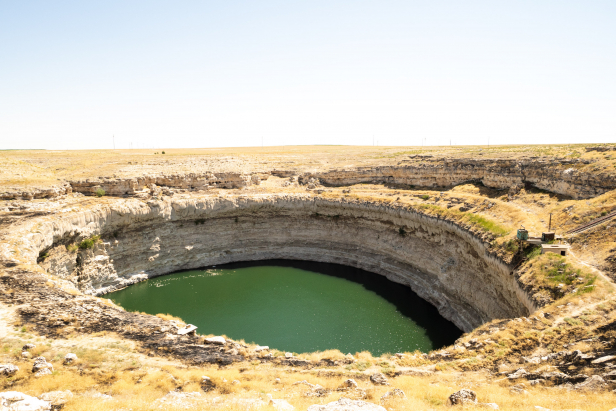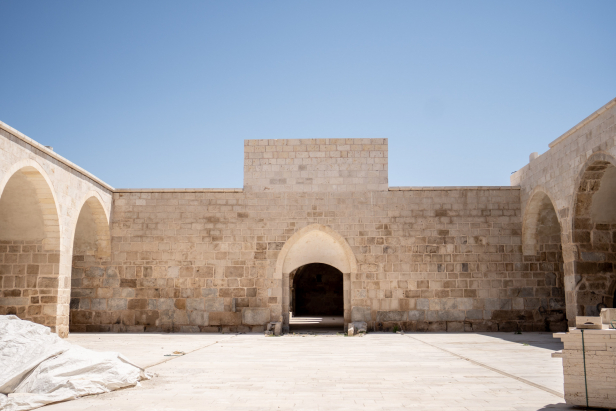Obruk Han Caravanserai and Kızören Sinkhole
(Obrukhanı Kızören Obruğu)
/ By Josh
Cost: To Be Determined
(As of our visit in 2022 the restoration on the Caravanserai was complete but the site was not yet open to visitors and so it is unclear if there will be an entry charge or how much it will be.)
Great for: Caravanserai, Silk Road, Seljuk History, Caravan, Medieval Motel
As you head east out of the city of Konya, the medieval capital of the Seljuk of Rum, the land flattens into a great plain, broken only by a line of low and barren mountains known as the Bozdağları. On the eastern side of the mountains the plains continue again, only this time the tilled fields are broken by stretches of low and bare land where saline water makes the soil lifeless. The winters here are harsh and the summers hot and dry.
Through this difficult landscape the Seljuks built one of their most important roads. A road that connected the capital city of Konya with the eastern cities of the sultanate for the movement of the military, messengers, and especially merchants. While the road was a used locally it was also a part of the vast Silk Road which connected Asia and Europe, connecting the markets of the vast swaths of the world. The control over sections of this road made rulers rich, and the Seljuks were no exception. So in this difficult place, the seljuks established a caravanserai, a fortified inn to promote and protect trade through Seljuk lands. The Seljuks chose a site next to a unique source of water: a vast sinkhole lake.
Why Visit?
Known as Obruk Han for its location next to the “obruk”, or sinkhole, the origins of the han are unclear. Without the inscription stone that would have usually been set above the outer door, the date of the caravanserai’s construction and its patron are unknown. Based on what is known of the history of the area and especially this stretch of the Silk Road, Obruk Han has been dated to sometime in the early 13th century between 1220 and 1250. With Sultanhanı (built 1229) to the east and Zazadin Han (built 1235) to the west, it is believed that Obruk han would have been built in conjunction with these.
While most caravanserai were named after their patron (Sultanhanı, Karatayhan, Ertokuş Caravanserai etc.) this caravanserai seems to have been known as Obruk Han from a very early date with records from the 13th century already naming it after the neighboring sinkhole.
Subscribe to The Art of Wayfaring

The Seljuk Caravanserai is one of the the Seljuk period’s most enduring examples of the culture’s artistry and strength. While Obruk Han is similar to most Seljuk Caravanserai in design, it is quite plain, lacking the grandeur and artfulness of other Seljuk period hans (see Incirhan, Sahipata Hanı, Karatay Han, Sultanhanı for examples of ornate Caravanserai).

The design follows the standard layout of a large Seljuk caravanserai and is made up of two sections: an open courtyard surrounded by a vaulted arcade, and a long covered hall of three vaults entered through the courtyard portion. There was likely a dome over the hall though this has not survived and does not show up in any historic photographs of the site that we’ve been able to find. Seljuk caravanserai, like Seljuk architecture in general, tended to use kumbet, or pyramidal Cupolas where an octagonal drum was capped with an octagonal pyramid roof on the exterior while the interior featured a simple semi-circular dome. (See Ulu Kumbet, Gökemedrese, and even the Rumi Mausoleaum for examples of other Kümbets).
While the most striking part of a caravanserai was usually its main entrance or ‘crown portal’ topped by a high façade with intricate muqarnas and geometric tracery, the entrance of Obruk Han is sparse and even more castle-like than the average caravanserai. The gate structure is two storeyed and has arrow loops opening above the gate for defence and crenelations above, suggesting that defence played a larger role in the design of this han than of others.
Subscribe to The Art of Wayfaring
The titular “Obruk”, or sinkhole, is known as Kızören Obruğu, and is one of many sinkholes and mineral lakes in the area where the limestone bedrock erodes, forming caves underground that collapse into lakes such as this. There was also significant volcanic activity in the region, with Acı Gölü and Meke Gölü being fascinating examples.
How To Get There
General
While there is bus service along the Konya – Aksaray highway, Obruk Han is still another 4 kms off of this main road.
If you plan to visit by car, Obruk han is an easy site to reach, especially if you’re travelling between the ever-popular sights of Konya and Cappadocia. Obruk Han can be found just 4 kilometers north of the Konya – Aksaray highway (the 300, which roughly follows the old Silk Road route and passes by a number of other caravanserai along the way), 70 kilometers east of Konya and 80 kilometers west of Aksaray. At the village of Kızören a brown sign marked for Obruk Han will point you to the north off of the highway, follow this one country road till you see the caravanserai on your right.
For more about car rental and driving in Turkey make sure to read our full drivers guide.
Where To Stay
While Olbruk Han once served travellers, this hasn’t been the case for a few centuries so you’re going to have to look a little further afield. While there is some basic accommodation in the Town of Sultanhanı, Konya has the best set of options in the area.
Other Tips
Planning on visiting Obruk Han? Make sure to see our guides to neighbouring Zazadin Han, Sultanhanı, or the fascinating Karatayhan.
Subscribe to The Art of Wayfaring
Have any tips or info to add? Spot any mistakes? We’d love to hear about it.


